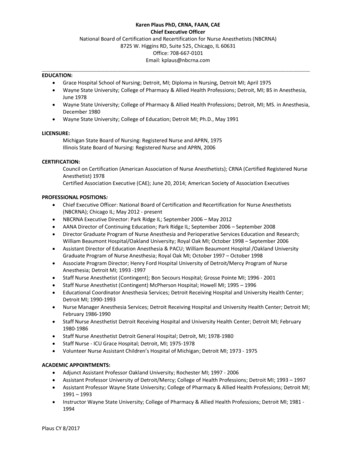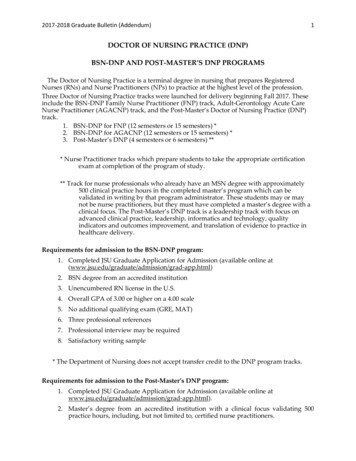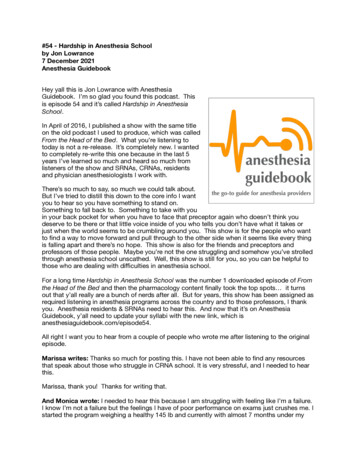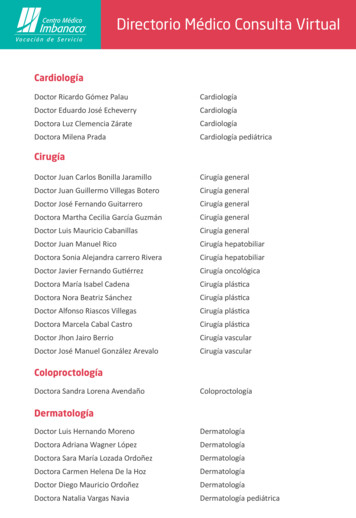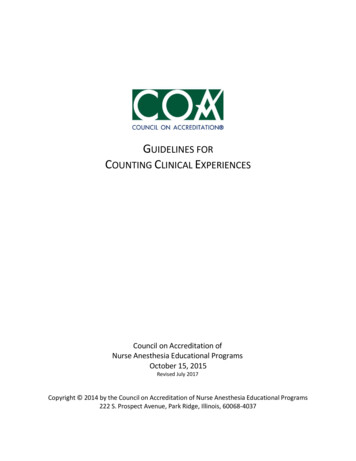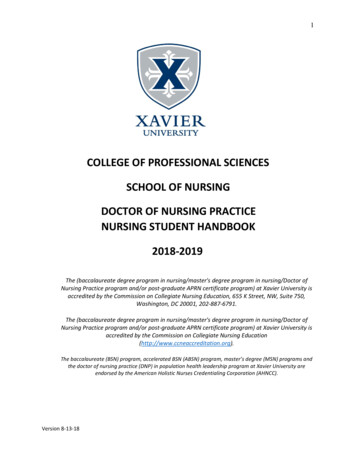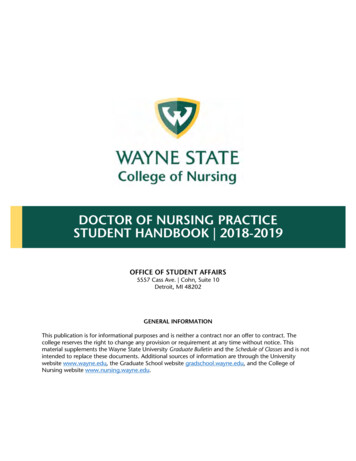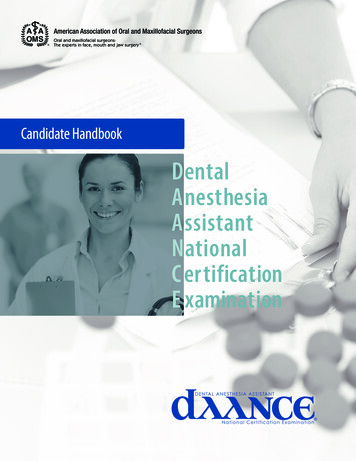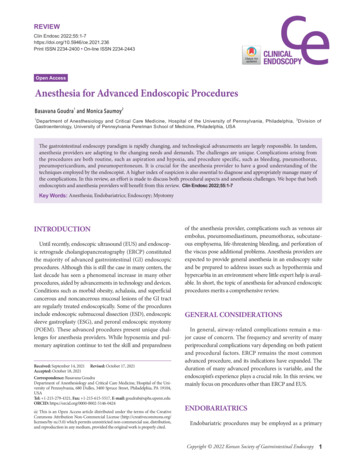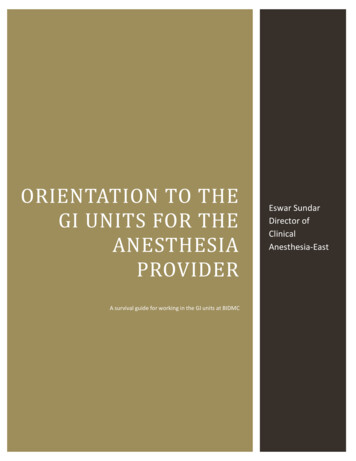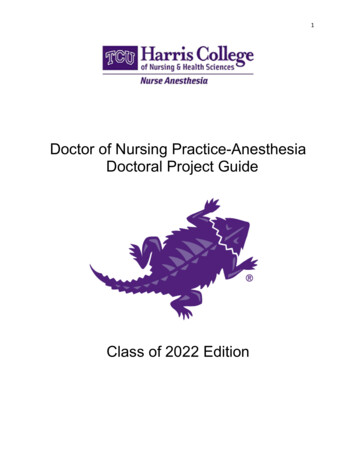
Transcription
1Doctor of Nursing Practice-AnesthesiaDoctoral Project GuideClass of 2022 Edition
2School of Nurse Anesthesia (SoA)TCU Box 298626Fort Worth, TX 76129817-257-7887www.crna.tcu.eduCopyright 2013All rights reserved. This book is protected by copyright. No part of it may be reproduced,stored in a retrieval system, or transmitted in any form or by any means, electronic,mechanical, photocopying, recording, or otherwise, without written permission from theauthors.Revised August 24, 2021
3Table of ContentsSection I: DNP-A Scholarly ProjectPhilosophy and PurposeOverview of Case-Study Focused ProjectSoA Faculty Information and InterestsFaculty AdvisingSection II: Case Study Focused Scholarly ProjectIn-Depth Examination of Clinical Case StudyElements of Scholarly Work1. Problem identification2. Detailed literature review3. Development of a strategy to address the problem4. Plan for implementation5. Dissemination6. Final paperExample of a Doctoral ProjectSection III: The DNP-A Scholarly PortfolioWhat Is a Scholarly Portfolio?Reflective Self-EvaluationsSection IV: TimelineDNP-A Scholarly Project Timeline and Portfolio Requirements Semesters 1–9Section V: Doctoral PresentationDoctoral PresentationEvaluation: Poster Evaluation RubricReferences
4Section IDNP-A Scholarly ProjectPhilosophy and PurposeOverview of Case-Study Focused ProjectSoA Faculty Information and InterestsFaculty AdvisingPhilosophy and PurposeThe Doctor of Nursing Practice-Anesthesia (DNP-A) Scholarly Project is about processand product, both aspects carry equal importance. The DNP-A Scholarly Projectprocess is organized and well-delineated to guide the clinically oriented doctoral studentto incorporate specific knowledge and skill sets that ultimately improve healthcaredelivery, clinical practice, and patient care. The School of Nurse Anesthesia (SoA)DNP-A Scholarly Project adheres to The Essentials of Doctoral Education for AdvancedNursing Practice put forth by the American Association of Colleges of Nursing (AACN)1and the goals, requirements, and competencies of the Council on Accreditation of NurseAnesthesia Educational Programs (COA).2AACN Final DNP Project“Doctoral education, whether practice or research, is distinguished by the completion of a specificproject that demonstrates synthesis of the student’s work and lays the groundwork for futurescholarship. For practice doctorates, requiring a dissertation or other original research is contraryto the intent of the DNP. The DNP primarily involves mastery of an advanced specialty withinnursing practice. Therefore, other methods must be used to distinguish the achievement of thatmastery. Unlike a dissertation, the work may take a number of forms.”1 One example of a finalDNP project is a practice change initiative. This may be represented by a pilot study, a programevaluation, a quality improvement project, an evaluation of a new practice model, a consultingproject, or an integrated systematic literature review. Additional examples of a DNP final productinclude a research utilization project, practice topic dissemination, substantive involvement in alarger endeavor, or other practice project. A DNP project would be expected to include amanuscript submitted for publication. The theme that links these forms of scholarly experiencesis the use of evidence to improve either practice or patient outcomes incorporating synthesis andscholarship.1
5“The final DNP project produces a tangible and deliverable academic product that is derived fromthe practice immersion experience and is reviewed and evaluated by an academic committee.The final DNP product documents outcomes of the student’s educational experiences, provides ameasurable medium for evaluating the immersion experience, and summarizes the student’sgrowth in knowledge and expertise. The final DNP product should be defined by the academicunit and utilize a form that best incorporates the requirements of the specialty and the institutionthat is awarding the degree. Whatever form the final DNP product takes, it will serve as afoundation for future scholarly practice.”1Essentials of Doctoral Education for Advanced Nursing Practice provide the framework forassessment of outcome competencies.1I. Scientific Underpinnings for PracticeThe DNP program prepares the graduate to:A. Integrate nursing science with knowledge from ethics, the biophysical, psychosocial,analytical, and organizational sciences as the basis for the highest level of nursingpractice.B. Use science-based theories and concepts to:1. determine the nature and significance of health and health care delivery phenomena;2. describe the actions and advanced strategies to enhance, alleviate, and amelioratehealth and health care delivery phenomena as appropriate; and evaluate outcomes.C. Develop and evaluate new practice approaches based on nursing theories and theoriesfrom other disciplines.II. Organizational and systems leadership for quality improvement and systems thinkingThe DNP program prepares the graduate to:A. Develop and evaluate care delivery approaches that meet current and future needs ofpatient populations based on scientific findings in nursing and other clinical sciences, aswell as organizational, political, and economic sciences.B. Ensure accountability for quality of health care and patient safety for populations withwhom they work.1. Use advanced communication skills/processes to lead quality improvement andpatient safety initiatives in health care systems.2. Employ principles of business, finance, economics, and health policy to developand implement effective plans for practice-level and/or system-wide practiceinitiatives that will improve the quality of care delivery.3. Develop and/or monitor budgets for practice initiatives.4. Analyze the cost-effectiveness of practice initiatives accounting for risk andimprovement of health care outcomes.5. Demonstrate sensitivity to diverse organizational cultures and populations,including patients and providers.C. Develop and/or evaluate effective strategies for managing the ethical dilemmas inherentin-patient care, the health care organization, and research.III. Clinical scholarship and analytical methods for evidence-based practiceThe DNP program prepares the graduate to:A. Use analytic methods to critically appraise existing literature and other evidence todetermine and implement the best evidence for practice.B. Design and implement processes to evaluate outcomes of practice, practice patterns,and systems of care within a practice setting, health care organization, or communityagainst national benchmarks to determine variances in practice outcomes and populationtrends.C. Design, direct, and evaluate quality improvement methodologies to promote safe, timely,effective, efficient, equitable, and patient-centered care.D. Apply relevant findings to develop practice guidelines and improve practice and thepractice environment.
6E. Use information technology and research methods appropriately to:1. collect appropriate and accurate data to generate evidence for nursing practice2. inform and guide the design of databases that generate meaningful evidence fornursing practice3. analyze data from practice4. design evidence-based interventions5. predict and analyze outcomes6. examine patterns of behavior and outcomes7. identify gaps in evidence for practiceF. Function as a practice specialist/consultant in collaborative knowledge-generatingresearch.G. Disseminate findings from evidence-based practice and research to improve healthcareoutcomesIV. Information systems/technology and patient care technology for the improvement andtransformation of health careThe DNP program prepares the graduate to:A. Design, select, use, and evaluate programs that evaluate and monitor outcomes of care,care systems, and quality improvement including consumer use of health careinformation systems.B. Analyze and communicate critical elements necessary to the selection, use andevaluation of health care information systems and patient care technology.C. Demonstrate the conceptual ability and technical skills to develop and execute anevaluation plan involving data extraction from practice information systems anddatabases.D. Provide leadership in the evaluation and resolution of ethical and legal issues withinhealthcare systems relating to the use of information, information technology,communication networks, and patient care technology.E. Evaluate consumer health information sources for accuracy, timeliness, andappropriateness.V. Health care policy for advocacy in health careThe DNP program prepares the graduate to:A. Critically analyze health policy proposals, health policies, and related issues from theperspective of consumers, nursing, other health professions, and other stakeholders inpolicy and public forums.B. Demonstrate leadership in the development and implementation of institutional, local,state, federal, and/or international health policy.C. Influence policy makers through active participation on committees, boards, or taskforces at the institutional, local, state, regional, national, and/or international levels toimprove health care delivery and outcomes.D. Educate others, including policy makers at all levels, regarding nursing, health policy, andpatient care outcomes.E. Advocate for the nursing profession within the policy and healthcare communities.F. Develop, evaluate, and provide leadership for health care policy that shapes health carefinancing, regulation, and delivery.G. Advocate for social justice, equity, and ethical policies within all healthcare arenas.VI. Interprofessional collaboration for improving patient and population health outcomesThe DNP program prepares the graduate to:A. Employ effective communication and collaborative skills in the development andimplementation of practice models, peer review, practice guidelines, health policy,standards of care, and/or other scholarly products.B. Lead interprofessional teams in the analysis of complex practice and organizationalissues.
7C. Employ consultative and leadership skills with intraprofessional and interprofessionalteams to create change in health care and complex healthcare delivery systems.VII. Clinical prevention and population health for improving the nation’s healthThe DNP program prepares the graduate to:A. Analyze epidemiological, biostatistical, environmental, and other appropriate scientificdata related to individual, aggregate, and population health.B. Synthesize concepts, including psychosocial dimensions and cultural diversity, related toclinical prevention and population health in developing, implementing, and evaluatinginterventions to address health promotion/disease prevention efforts, improve healthstatus/access patterns, and/or address gaps in care of individuals, aggregates, orpopulations.C. Evaluate care delivery models and/or strategies using concepts related to community,environmental and occupational health, and cultural and socioeconomic dimensions ofhealth.VIII. Advanced nursing practiceThe DNP program prepares the graduate to:A. Conduct a comprehensive and systematic assessment of health and illness parametersin complex situations, incorporating diverse and culturally sensitive approaches.B. Design, implement, and evaluate therapeutic interventions based on nursing science andother sciences.C. Develop and sustain therapeutic relationships and partnerships with patients (individual,family or group) and other professionals to facilitate optimal care and patient outcomes.D. Demonstrate advanced levels of clinical judgment, systems thinking, and accountability indesigning, delivering, and evaluating evidence-based care to improve patient outcomes.E. Guide, mentor, and support other nurses to achieve excellence in nursing practice.F. Educate and guide individuals and groups through complex health and situationaltransitions.Use conceptual and analytical skills in evaluating the links among practice, organizational,population, fiscal, and policy issues.
8Overview of Case Study Focused Scholarly ProjectThe DNP-A case study focused project may vary in its form and focus but is alwaysbased on use of evidence to improve either practice or patient outcomes incorporatingsynthesis and scholarship. Evidence-based practice embodies the philosophicalunderpinning for all DNP-A clinical projects. Evidence-based practice is a process thatincludes locating, appraising, and applying quality scientific evidence.3 Evidence-basedpractice is the conscientious, explicit, and judicious use of current best evidence inmaking decisions about the care of individual patients.3,4 The RRNA uses the portfolioprocess to gain new knowledge from primary research, translate existing researchfindings, and/or focus on implementing known best practices. Application of evidencebased methodology through the translation of research, evaluation of practice, andcollaboration results in improvement of healthcare practice and outcomes.5The case study focused scholarly project consists of an evidence-based inquiry thatis centered around a problem that is identified in the clinical setting. The doctoralstudent will utilize the scholarship skills gained from doctoral coursework to date toapply academically sound scholarship skills with the goal of improving clinical practice.The elements (also referred to as “steps”) of the scholarly work include: 1)identification of a problem; 2) conducting a detailed literature review; 3)developing a strategy to address the problem; 4) making a plan forimplementation; 5) dissemination of the scholarly project; and finally, 6) bringingtogether all elements into a final scholarly paper that is inclusive of all elements.DNP-A case study focused scholarly project objectives:The DNP-A clinical project is a scholarly process that will assist the DNP-A student to: Appraise evidence to implement the best evidence for practice; Develop an evidence-based project through problem identification, a review ofthe literature, identification of a strategy to address the problem, plan forimplementation, dissemination, and evaluation. Culmination of the project bringstogether all elements into a final scholarly paper; Design processes to evaluate outcomes of practice and systems of care; Use information technology systems for storage and retrieval of data; Apply analytical methodology to synthesize existing literature relevant to nurseanesthesia practice; Disseminate project results in a professional manner both written and orally; Develop strategies to translate research into practice.
9SoA Faculty Information and InterestsRon Anderson, MDAssociate Professor of Professional PracticeBS (University of Texas) 1981; MD (Texas Tech University School of Medicine) 1987Project interests include obstetric and regional anesthesia, pain management,impaired cognitive development following fetal or early childhood anesthetic exposure,medical ethics, effective healthcare resource utilization, obstructive sleep apnea, andperioperative medical optimization.Dennis J Cheek, PhD, RN, FAHAProfessorBSN (California State University, Fresno), 1982; MSN (University of California, SanFrancisco), 1988; PhD (University of Nevada, Reno), 1996;Project interests include cellular & biological Sciences, the genetic/genomiccellular/tissue expressions and subsequent clinical presentation, the role of functioningendothelial cells and subsequent causative factors involved in the development ofdysfunctional endothelial cells including the genetic and genomic implications, the roleof HSP72 in acute heat shock as well as heat acclimation during bouts ofexercise. Clinical Interests: cardiovascular disease in women and men, disparities inrisk factors, clinical presentations and treatment of men and women with heart disease,the role of hormones in heart disease, the role of aerobic versus resistive exercise as apreventive measure in the development of heart disease.An additional growing area of clinical interest is the interplay of pharmacologyand the genetic makeup of the patient or pharmacogenomics and the increasetranslation of pharmacogenomics into clinical practice so that adverse drug reactionscan be reduced or avoided and doses are optimized.Greg Collins, DNP, CRNAAssistant Professor of Professional PracticeBSN (West Texas A&M University), 2002; MSNA (Texas Christian University), 2006;DNP (Texas Christian University), 2018.President of Operations for the Texas division of EmergencHealth. He maintainsa general clinical practice in Granbury, TX. Dr. Collins completed both his initialanesthesia training and subsequent Doctor of Nursing Practice degree at TexasChristian university. He is a veteran of the US Army Reserves having delivered downrange anesthesia in support of both Operation Iraqi Freedom and Operation New Dawn.Dr. Collins currently serves as President of the Texas Association of Nurse Anesthetists(TxANA), representing more than 4,500 CRNAs.M Roseann Diehl, PhD, DNP, CRNA, CHSE-AProfessor of Professional PracticeBSN (University of Texas), 1987; MHS (Texas Wesleyan University), 1997; DNP (TexasChristian University), 2010; PhD (Texas Woman’s University), 2016.
10Project interests include systematic reviews and clinical projects related tosimulation, anesthesia crisis resource management, debriefing, selfassessment/reflection, nurse anesthesia education, regional anesthesia and portfoliomanagement.Vaughna Galvin, DNAP, CRNAAssistant Professor of Professional PracticeBSN (Barton College), 1997; MA (East Carolina University), 2002; MSNA, (TexasChristian University), 2005; DNAP, (Virginia Commonwealth University), 2011.Project interests include: Gross anatomy, regional anesthesia anatomy, point-ofcare ultrasound assessment, anesthesia crisis resource management, and criticalscenario simulation.James Holcomb, DNP, CRNAAssistant Professor of Professional PracticeBA (Texas Tech University), 1993; Diploma (Methodist Hospital School of Nursing,Lubbock), 1995; BSN (West Texas A & M University), 1997; MHS (Texas WesleyanUniversity), 1998; Certificate in Nurse Anesthesia (Texas Wesleyan University), 1999;DNP (Texas Christian University), 2012.Monica Jenschke, PhD, CRNAAssociate Professor of Professional PracticeAssistant Director, Advanced Pain Management Fellowship.Director, DNP-A ProjectsBSN (University of Texas Health Science Center School of Nursing at San Antonio);MHS (Texas Wesleyan University); PhD (University of North Texas Health ScienceCenter at Fort Worth).Project interests include: The effect of aging on postoperative pain, use ofmultimodal analgesia/anesthesia techniques, NMDA antagonists in reducing opioidtolerance and opioid-induced hyperalgesia, perioperative fluid management,pharmacology, incorporation of TeamSTEPPS into healthcare culture, and fosteringhealth and wellness in nurse anesthesia.Jennifer Oakes, DNAP, CRNA, CHSEAssociate DirectorAssociate Professor of Professional PracticeDNAP (Virginia Commonwealth University) 2011; MSNA (Virginia CommonwealthUniversity) 2010; BSN (University of Phoenix) 2008.Project interests include: Anesthesia Crisis Resource Management, Simulation,professional aspects, conflict resolutions and curriculum development.Julie A Pearson, PhD, CRNAAdjunct FacultyBSN (Rush University), 1980; BS Nurse Anesthesia (George Washington University),1987; MSN (Rush University), 1993; PhD (Virginia Commonwealth University), 2006.
11Project interests include: professional satisfaction, program accreditation, clinicaloutcomes, competence and confidence, pediatric anesthesia, professional socialization,leadership development.J Dru Riddle, PhD, DNP, CRNA, FAANAssociate Professor of Professional PracticeBSN (Virginia Commonwealth University), 1999; MSN (Old Dominion University), 2002;DNP (Texas Christian University), 2011; PhD (Medical University of South Carolina),2014.Project interests include: pharmacogenomics, OB anesthesia (high risk OBpatient management), anesthesia pharmacology, preoperative evaluation and riskstratification, evidence-based practice, implementation science, cost-effectivenessanalysis, cost-benefit analysis, JBI/systematic reviews, international anesthesiapractice, healthcare economics, and healthcare policy.Jackie Rowles, DNP, MBA, MA, CRNA, NSPM-C, ANP-BC, FNAP, DAIPM, FAANAssociate Professor of Professional PracticeDirector Advanced Pain Management FellowshipBSN (Ball State University), 1982; MBA (University of Memphis), 1988; Certificate inNurse Anesthesia (Truman Medical Center School of Nurse Anesthesia), 1994; MABiology (University of Missouri Kansas City), 1994; Post Master’s Certificate AdultNurse Practitioner (Ball State University) 2013; DNP (Barry University) 2016.Project interests include: pain management, professional aspects, internationalanesthesia education and practice, competency assessment, wellness.Robyn C Ward, PhD, CRNADirectorAssociate Professor of Professional PracticeBSN (Montana State University), 1990; MS Nurse Anesthesia (Georgetown University),2000; PhD (Rush University), 2018.Project interests include: psychometrics of testing, lifelong learning, educationand certification, simulation-based assessment for decision-making and competence,obstetric anesthesia, and regional anesthesia techniques.Faculty AdvisingDoctoral-prepared faculty in the school of nurse anesthesia will serve as primaryadvisors. Primary faculty advisors are paired with secondary advisors, which enhancesoversight and feedback to the advisee. Advisor-advisee assignments will be made bythe director and associate director.Both faculty and students have specific responsibilities toward the progress of theproject. Communication is extremely important throughout the entire project processand is the student’s overall responsibility. The timeline and deadlines of each project are
12designed to facilitate continual progress. Failure to meet requirements and deadlinesmay jeopardize timely completion of the project and ultimately, graduation. Delays oromissions in the timeline must be clearly discussed with faculty advisor and resolved.All projects are to be completed on time to avoid graduation delays. Some specificresponsibilities of student and faculty are listed below:Student responsibilities: Communicate regularly with primary advisor via in-person, phone, Zoomconferencing, and/or email. Keep all documentation of communications andreplies for records. Closely follow the timeline for projects completing each requirement completelyand on time. Uploads of all work must be submitted by the deadline, to thestudent’s portfolio AND to D2L as assigned for that semester. It is the student’s responsibility to adhere to the syllabus, the DNP guide andrequirements in D2L to ensure timely submission of documents. Repeatedfaculty reminders may result in a grade of zero for that requirement and/or agrade of Incomplete for the semester.Faculty responsibilities: Respond to student communications in a timely fashion. Provide, at a minimum, semester progress feedback, guidance, and evaluation. Communicate and coordinate student progress with the students themselves andwith the secondary advisor. Provide guidance and formative feedback in construction of poster presentationfor the annual Research Symposium held in late April or early May. Provide guidance and feedback for progression of case study focused scholarlyproject.
13Section IICase Study Focused Scholarly ProjectIn-Depth Examination of Clinical Case StudyThe case study focused scholarly project represents an evidence-based inquiry processusing scholarship skills, resulting in an academically sound product to improve clinicalpractice. The project interweaves phase I content (didactic courses) and phase II(clinical experience and courses). The scholarly work consists of six steps to becompleted over the course of clinical practicums I, II, and III, and IV. Each step of theproject is intended to build upon the previous steps to culminate into one final paper thatincludes each step and process.Elements of Scholarly WorkThe 6 elements (steps) include:1. Problem identification;2. Retrieval, review, and synthesis of existing evidence from the literature;3. Development of a strategy to address the problem;4. Plan for implementation;5. Dissemination; and6. Final paper.Step 1: Problem Identification (Clinical Practicum I)The RRNA will identify and define a problem related to nurse anesthesia practice; thiswill be the focus of the scholarly project. The problem will originate in the clinical milieu,and is clinically based, but the problem may include educational and/or professionalcomponents.Through the course of clinical residency, students are exposed to a variety of clinicalcases that represent the need to reference current literature. Students will select onecase or problem of interest that identifies new research, techniques, and evidencebased practice. The case study focused project delves deeply into various aspects ofclinical anesthesia integrating pharmacology, physiology, pathophysiology, andprinciples of translational research.Step 2: Retrieval, review, and synthesis of existing evidence from theliterature (Clinical Practicums I and II)Literature reviews are a requirement for all projects. A review of the literature inclusiveof an appraisal with implications and/or recommendations for practice offers breadth,
14depth, and scope to a project. This step evaluates literature search skills and criticalthinking. The literature review should be submitted in table format with an evidenceappraisal table.Deliverables for Steps 1 and 2 (Clinical Practicums 1 and 2)1. Evidence Appraisal TableAn evidence appraisal table provides a wonderful snapshot and efficient method learnabout topic. You likely have seen versions of these tables when reading systematicreviews and/or meta-analyses. Formulating an evidence appraisal table is excellentpreparation for gathering information to provide a "bird's eye view" for any scholarlyproject. Collecting quality evidence is useful, but writing annotations for each reference,forces you to read each source more carefully. The information gathered is criticallyanalyzed and visually compared. What is known, not known, and other gaps can moreeasily be identified during this process as well2. Scholarly Project Paper #1The scholarly project paper will demonstrate translation of research into practice andinterdisciplinary collaboration to provide a basis for evaluation of patient care.9 Thescholarly project paper will be based on an actual patient encounter. Ideally, theselected case will be one where you personally provided the anesthesia. Recognizingthat the case identification is early in the clinical residency, options for selecting a casemay also come from observed events or even from a case that occurred at your clinicalsite, yet you were not directly involved. If you only observed or were not directlyinvolved in the case, you must be able to obtain patient records and speak withindividuals who were directly involved in the care of the patient.The scholarly project is centered on an actual patient case. The direction of the projectexploration can be 1) clinical, 2) educational, or 3) professional.The case summary for a clinical, practice evaluative scholarly project should provide athorough description of the patient, procedure, medications, perioperative issues, andactions taken to prevent or resolve issues. Consult with your faculty advisor and thepaper by Shelton et al within the D2L course for guidance.The format conforms to instructions from the AANA Foundation’s “State of the Science”to include poster session guidelines for poster abstract submission to the AnnualCongress and instructions for authors to submit a case report for publication in theAANA Journal.The following format will be used for the Scholarly Project Paper #1; students willchoose option 1 (clinical focus) or option 2 (educational or professional focus):1. Clinical focusa. Structured abstract Introductiono 1050 characters (including spaces) or less
15 b.c.d.e.f.g.h.i.j.o Introduce focus of the reporto Relevant etiology, epidemiologyCase presentationo 1400 characters (including spaces) or lesso Relevant patient historyo Perioperative courseDiscussiono 1750 characters (including spaces) or lesso Present current literature and how it relates to the reported caseKey words, 3-5IntroductionCase summaryEvidence Search MethodReview of the LiteratureSynthesis of the Literature (Discussion)Recommendations for practice (Conclusions)SummaryReference list2. Educational or Professional focusa. Structured abstract Background / Purpose / Questiono 875 characters (including spaces) or lesso Define the nature and significance of the problemo Clearly stated purpose of the projecto Clearly stated questions that your project addresses Methods / Evidence Searcho 1050 characters (including spaces) or lesso Method clearly described and reproducibleo Database search and keywords clearly described andreproducibleo Outline statistical/analysis plan as appropriate Synthesis of Literature / Results / Discussiono 1400 characters (including spaces) or lesso Clearly presented and consistent with purpose and questionso Point out relevance of findings to other published worko Highlight future directions of the research Conclusion / Recommendations for Practiceo 1050 characters (including spaces) or lesso Concise summary addressing relevanceo Provide recommendations for future practiceb. Key words, 3-5c. Introductiond. Case summary
16e.f.g.h.i.j.Evidence Search MethodReview of the LiteratureSynthesis of the Literature (Discussion)Recommendations for practice (Conclusions)SummaryReference list** see Scholarly Project Templates in NRAN 88080 within D2LStep 3: Develop a Strategy to Address the Problem (ClinicalPracticum II)This step should demonstrate problem solving and critical thinking skills. Currentmethodologies and theories shou
The Doctor of Nursing Practice-Anesthesia (DNP-A) Scholarly Project is about process and product, both aspects carry equal importance. The DNP-A Scholarly Project process is organized and well-delineated to guide the clinically oriented doctoral student to incorporate specific knowledge and skill sets that ultimately improve healthcare
